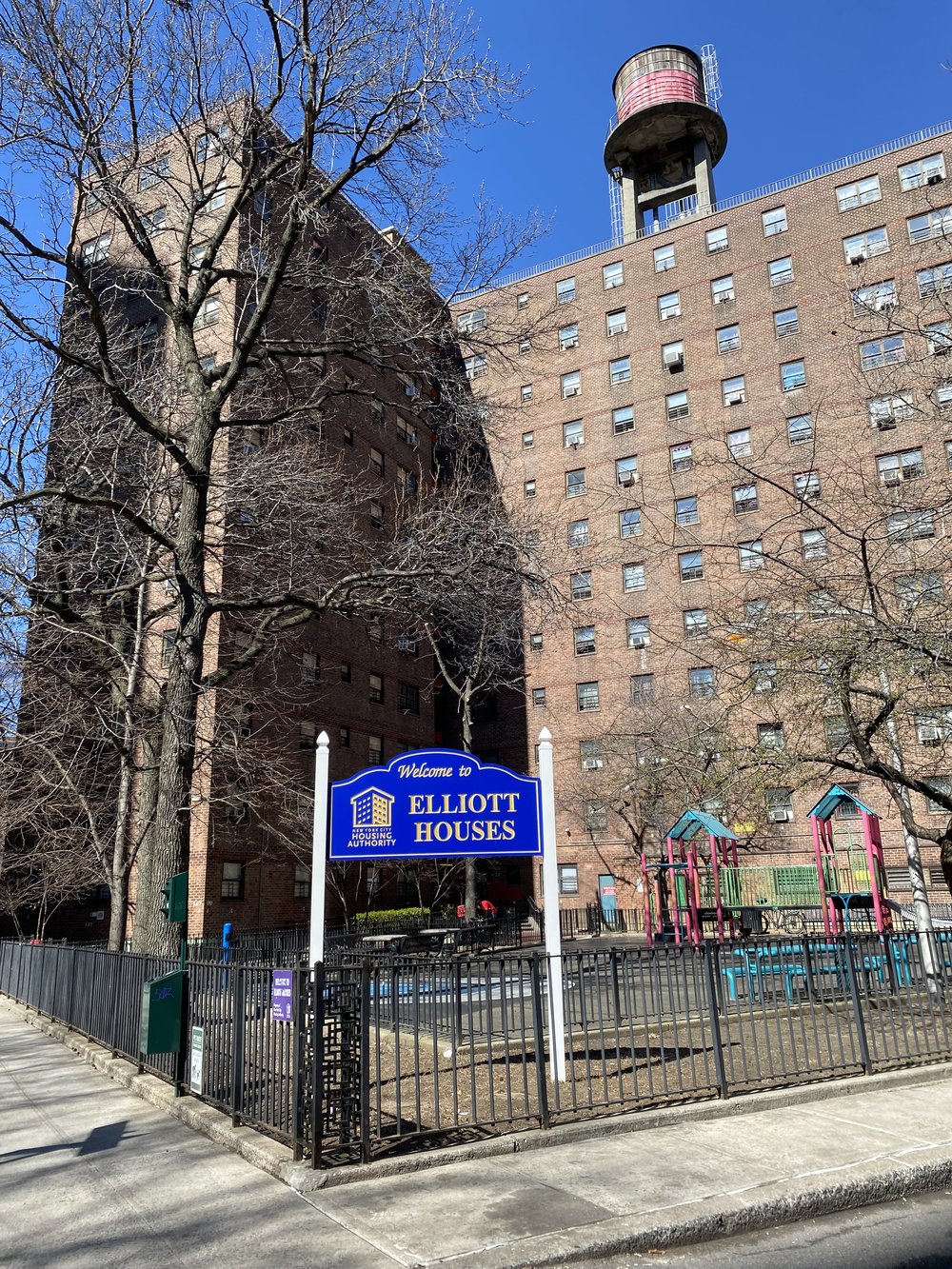Tenants vote to demolish and rebuild Chelsea public housing complexes
June 20, 2023, 9:18 p.m.
Most tenants who voted in an informal survey said they supported a controversial plan to tear down their buildings and replace them with new complexes, alongside luxury housing.

The majority of tenants who voted at a pair of public housing complexes opted to support a controversial proposal to tear down and replace their apartment buildings in Chelsea, Gothamist has learned.
More than half of the roughly 950 tenants of the Fulton and Chelsea Elliott Houses who voted in a non-binding survey this spring said they backed the demolition plan, which the city plans to release tomorrow, the New York City Housing Authority confirmed to Gothamist Tuesday night.
The vote does not commit the city to tearing down the public housing complexes, but kicks off a new phase of planning, with private developers and NYCHA now pursuing the demolition proposal. The vote comes just two years after residents at the complexes rejected a similar demolition idea following an exhaustive community process.
The tear-down plan was put forth by developers Related Companies and Essence, companies previously selected by tenant leaders to run the properties under a switch to private management. The firms estimated that the original plan to renovate the existing apartments would cost about $1 billion – around the same price as rebuilding from the ground up.
The tenant vote to demolish the complexes comes as the beleaguered public housing agency is currently facing more than $40 billion in needed capital repairs after decades of disinvestment.
The rebuilding proposal would also allow the developers to erect a mix of 3,500 new luxury and income-restricted apartments on the current grounds of the NYCHA campuses, which are located in the shadow of Related’s Hudson Yards on some of the world’s most valuable real estate.
The proposal would depend on rezoning approval to build large complexes and add the market-rate housing.
The New York Times first reported on the result of the survey.
NYCHA and Mayor Eric Adams say they also support the proposal.
“No one knows better than the residents what they and their neighbors need, and they were
smart to recognize the potential benefits of completely rebuilding their campus,” Adams said in a statement.
The public housing agency and the developers worked with tenant leaders to organize meetings with other residents between March and May, ahead of the survey vote. Residents cast ballots online or in paper form.
The non-binding vote was open to anyone 18 and older named on a lease at the two complexes, which are home to around 4,500 tenants across 2,055 apartments. They could choose one of three options: rebuild within the existing zoning rules that limit height and usage, rebuild and pursue a rezoning to allow for bigger buildings and a range of uses, or rehabilitate the current buildings. Most chose to rebuild.
But a complete teardown would mark a major departure from current practices.
New York City has avoided all but a handful of modest demolitions even as public housing agencies across the country tear down their buildings and issue housing vouchers to tenants to find apartments on the open market. That has left residents in cities like New Orleans and Chicago without a place to go amid a housing shortage.
The developers say they would build the new public housing towers while tenants continue living in the existing ones. After they complete a new building, tenants would move in from the old one. The empty buildings would be torn down to make way for the new public housing or market-rate complexes.
Essence CEO Jamar Adams said tenants will maintain their same lease rights, though residents have raised questions about what happens to tenants who owe rent, who live in larger apartments or who share their units with family or friends.
The tear-down plan has the support of tenant leaders, including Darlene Waters, president of the Chelsea-Elliott Houses Tenant Association, and Miguel Acevedo, president of the nearby Fulton Houses.
Acevedo said “exit polling” suggested that most tenants who participated in the survey backed the plan, but he did not know the results.
Waters said she did not know either, but was happy residents are having a say in the process.
“That’s the main thing. They had a choice to vote for something they wanted or needed,” Waters said. “Anything is better than what we have now.”
She said tenants would meet with NYCHA and the developers to discuss “next steps” at a meeting on June 27. The public housing agency says there are still several roadblocks to clear, including zoning restrictions, as part of a likely six-year timeline for redevelopment.
But many tenants are expressing their skepticism or denouncing a plan to demolish their apartments.
Rodney Johnson, a cook who has lived in the Elliott Houses since 2013, told Gothamist in March that he worried tenants in good-standing or with connections would get “priority” for new buildings. He also feared what would become of tenants who owe back rent.
“It’s not going to be that easy,” he said. “What’s important to them is making sure you pay your rent.”
Flyers posted by a group identifying itself as the “Homekeepers Union” urged residents to vote for the option to rehabilitate the existing buildings, rather than demolish the apartments to build new ones.
“Keep the wolf from the door!” the flyers read.
Once a long shot, a plan to demolish and rebuild Chelsea public housing complex sees new life